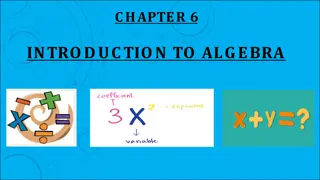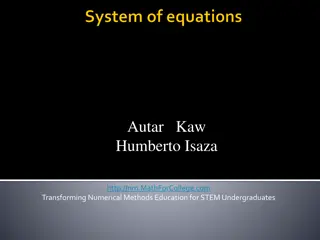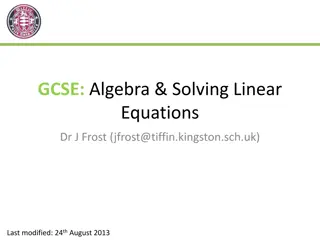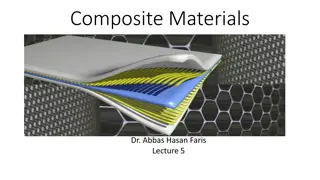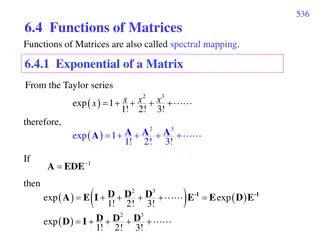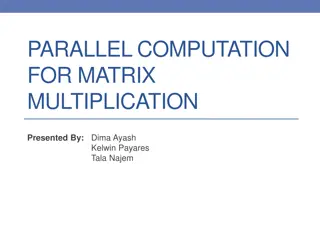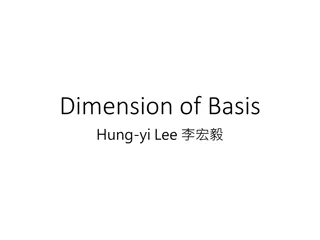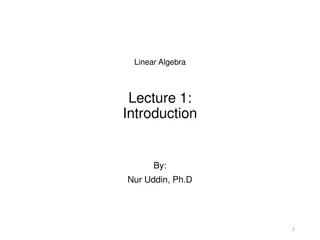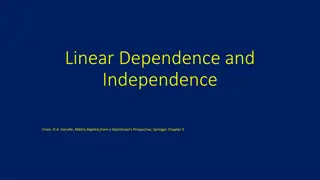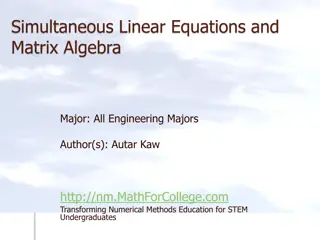
Understanding Matrix Algebra: Operations, Definitions, and Examples
Dive into the world of matrix algebra with this comprehensive guide covering operations like addition, transposition, and matrix multiplication, as well as key definitions and examples to deepen your understanding. Explore special matrices, identity matrices, triangular matrices, the transpose of a matrix, symmetric matrices, and more.
Download Presentation

Please find below an Image/Link to download the presentation.
The content on the website is provided AS IS for your information and personal use only. It may not be sold, licensed, or shared on other websites without obtaining consent from the author. If you encounter any issues during the download, it is possible that the publisher has removed the file from their server.
You are allowed to download the files provided on this website for personal or commercial use, subject to the condition that they are used lawfully. All files are the property of their respective owners.
The content on the website is provided AS IS for your information and personal use only. It may not be sold, licensed, or shared on other websites without obtaining consent from the author.
E N D
Presentation Transcript
Chapter 2 Matrix algebra
Introduction web1 1 2 2 web2 2 2 1 web3 3 1 1 Web1 Web2 Web3 A (0, 0) (3, 5) (2, 3) 0 5 2 4 3 0 0 3 3 5 (4, 3) (5, 0)
OUR GOAL Matrices Special matrices Operations on matrices: Addition Difference Transposition Scalar multiplication Matrix multiplication Inverse of a square matrix Matrices and linear systems of equations Matrices and linear transformations
Definition An mxn matrix is rectangular array of numbers (m x n): size of the matrix A = [aij] // aij is called (i, j)-entry
Matrices - examples An 2x3 matrix // 2 rows, 3 columns Read: two by three matrix (1,3)-entry a[1,3] = 1/2 a13 = 1/2 7 -3 1/2 A = 3 -5 0 3 x 3matrix, a square matrix 3 x 1 matrix column matrix
Special matrices Zero matrix 0mxn 02x3 = 0 0 Main diagonal of a matrix 0 0 0 0 3 0 1 2 4 7 3 , 4 2 1 3 0 5 2 1
Identity matrices Identity matrix: square matrix [aij] where aij = 1 if i = j and aij = 0 if i j 1 0 0 0 1 0 0 0 1 ?3=
Triangular matrices Upper triangular matrix: 3 0 0 13 1 0 7 6 2 Lower triangular matrix: 3 0 0 0 2 11 2 1 3
Transpose of a matrix mother Bob Eva Susan Lan Alice 1 0 0 Minh 0 0 1 Nam 0 0 1 0 1 0 son/daughter Bob Alice Minh Nam Eva 0 1 0 0 Susan 1 0 0 0 Lan 0 0 1 1
Transpose of a matrix The transpose of an mxn matrix [aij] is an nxm matrix [aji] Notation: AT // the transpose of A Example ? =2 1 Then, 3 5 1 0 2 3 1 5 0 ??= 1
Symmetric matrices Square matrix [aij] where aij = aji or AT = A 1 2 5 2 3 7 5 7 4 ? = 1 2 5 2 3 7 5 7 4 ??= ? =
operations on matrices Addition A + B = [aij + bij] Difference A B = [aij bij] Scalar multiplication Matrix multiplication The same size matrices
Addition. Difference Scalar multiplication day 1 addition difference day 1 + day 2? day 1 day 2? 2(day 1)? day 2 Scalar multiplication 110 300 35 230 155 117 280 389 201
Properties Suppose A, B, C are mxn matrices, k is a number: 1. A + B = B + A 2. A + (B + C) = (A + B) + C // associative law 3. k(A + B) = kA + kB 4. (A + B)T = AT + BT // commutative law // distributive law
Matrix multiplication - introduction peanuts 8 15 soda 5 7 hot dogs 12 13 group A group B selling price store 1 store 2 store 3 store 4 peanuts 2 2.5 2 2.5 soda 2.5 2 2.75 2 hot dogs 3 3 2.5 3 8x2.5 + 5x2 + 12x3 = 66$ store 1 store 2 store 3 64.5 66 86.5 87.5 store 4 66 90.5 group A group B 59.75 81.75
Matrix multiplication Am n . Bn p = Cm p //suitable size The entry cij = (row i of A).(column j of B) 1.1+2.1 3 3 1 2 4 4 1 1 2 2 0 0 1 1 0 1 2 0 = 0 1 -2 -2 -1 -1 -1 -1 1 2 0 2 0 0 2 2 -4 -2 -2
Properties 1. A(B + C) = AB + AC 2. A(BC) = (AB)C 3. (AB)T = BTAT //distributive law //associative law Note: In general, AB BA Not commutative AB = 0 A = 0 or B = 0 AB =AC B = C
Example A (0, 0) (3, 5) (2, 3) 0 5 2 4 3 0 0 3 3 5 (4, 3) D= (5, 0) A Let A = 2 0 2 ,???? ??. 0 0 10 4 8 6 0 0 6 6 10
The inverse of a matrix In numbers: 3.(1/3) = 1 and 1/3 or 3-1 is called (multiplicative) inverse of 3. In matrices: An nxn matrix B is called the inverse of an nxn matrix A if AB = BA = In The inverse of A is denoted by A-1. AA-1 = A-1A = In 1 4 1 3 is the inverse of 3 4 1 Example. 1
The inverse of 2x2 matrices 2 -3 1 -4 A = -4 -1 3 1 -5 A-1 = 2 -4.2 3.(-1) = -5 // determinant of A, denoted by det(A)
The inverse of nxn matrices The Inversion algorithm: [A | In] [In |A-1] For example, A -r2 1 0 0 1 1 2 2 3 1 0 0 0 1 0 0 0 1 1 0 0 1 1 2 2 1 0 0 0 0 0 1 3 5 1 0 5 -2r3 + r1 -2r2 + r3 1 0 0 1 1 0 2 1 0 0 0 0 0 1 1 0 0 1 1 0 0 0 1 1 0 0 4 5 2 2 3 1 3r3+ r2 3 1 1 2 1 0 0 0 1 0 0 0 1 1 0 0 1 5 2 1 3 1 A-1
Linear equation and matrix multiplication ? ?= 2 3 A X = B 2x + y 3? 2? -2x + y = -1 3x -2y = 5 1 1 5 2 1 5 = AX = B X = A-1B X = 2 1 2 1 5 3 7 x = -3, y = -7 = 3
Matrix and linear transformation Example of a transformation T(x, y) = (x, -y) T? ? = ? 1 0 0 1 y ? input (x, y) ? ?= ? ? x (x, -y) output input output Matrix of The transformation
Matrix and linear transformation Example of a transformation y S(x, y) = ? Find the matrix of S? input (x, y) x (-x, -y) output
Suppose T is a linear transformation given by the matrix 1 2 3 0 Find T(1, 2, -3). 1 2 1 2 1 2 1 3 2 0 1 2 6 3 T(1, 2, -3) = T = = 3 3
The composition of transformations Given T(x, y) = (x, y-x) T? ? = ? ? And S(x, y) = (x-y, y) S? ?= ? Find the composite transformation (T S)(x, y) defined by (T S)(x, y) = T(S(x, y)) ? 1 0 1 1 ? ? 1 0 1 1 Matrix of T S: 1 0 1 1 = 1 (T S)? 1 0 1 1 1 1 2 ? ? ? + 2? ?=
The inverse of a transformation - introduction transformation Encoded mess encode Message decode Encoded mess Message Inverse transformation
Theorem If the matrix of T is A, then the matrix of T-1 is A-1 Example. Given T(x, y) = (x y, -x + 2y), find T-1, the inverse of T. Solution. T? ?= T-1 has the matrix 2 T-1? ?= ? + ? Note that (T T-1)? ?= ? ? ? + 2? has the matrix 1 1 2 1 1 1 1 2? + ? ? ?
The inverse of a transformation Example in cryptography Encrypt the message STOP by the transformation T(x, y) = (x - 3y, -x + 4y) S T O P 19 20 15 16 ? = 15 T(x, y) = (x - 3y, -x + 4y) Matrix of T, M = Encryption: MD = 1 message: -26 -28 41 44 Decryption: from D find D and the inverse of M Note that MD = D D = M-1D 19 20 16 1 3 4 1 19 15 20 16 1 3 4 26 41 28 44 = = ?


